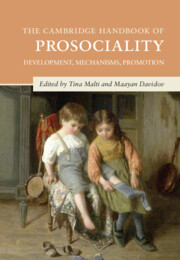Book contents
- The Cambridge Handbook of Prosociality
- Cambridge Handbooks in Psychology
- The Cambridge Handbook of Prosociality
- Copyright page
- Dedication
- Contents
- Figures
- Contributors
- Part I Development of Prosociality
- Part II Antecedents and Mechanisms of Prosociality
- Part III Development of Prosociality in Context
- 18 Parenting and Children’s Prosociality
- 19 Sibling Influences on Prosociality
- 20 Prosocial Behavior, Peer Relationships, and Friendships
- 21 Children’s Intergroup Prosocial Behavior
- 22 Prosocial Behavior in School Contexts
- 23 Community and Neighborhood Influences on Prosociality in Children and Youth
- 24 Culture and Prosociality
- 25 Prosocial Media
- Part IV Applications
- Index
- References
25 - Prosocial Media
from Part III - Development of Prosociality in Context
Published online by Cambridge University Press: 25 May 2023
- The Cambridge Handbook of Prosociality
- Cambridge Handbooks in Psychology
- The Cambridge Handbook of Prosociality
- Copyright page
- Dedication
- Contents
- Figures
- Contributors
- Part I Development of Prosociality
- Part II Antecedents and Mechanisms of Prosociality
- Part III Development of Prosociality in Context
- 18 Parenting and Children’s Prosociality
- 19 Sibling Influences on Prosociality
- 20 Prosocial Behavior, Peer Relationships, and Friendships
- 21 Children’s Intergroup Prosocial Behavior
- 22 Prosocial Behavior in School Contexts
- 23 Community and Neighborhood Influences on Prosociality in Children and Youth
- 24 Culture and Prosociality
- 25 Prosocial Media
- Part IV Applications
- Index
- References
Summary
Children and adolescents spend a great deal of time with a variety of media, raising the important question of whether media might influence the socialization of children. Although copious research has found consistent links between violent media content and children’s aggression, research has also found that prosocial media influences the development of prosocial behavior for both children and adolescents. Thus, in this chapter we review theoretical justifications for why and how prosocial media content impacts young people, and then synthesize existing research on the effects of different mediums of prosocial media on child outcomes. This review includes traditional media (e.g., TV, movies, video games, music, books) and new media (e.g., cell phones, tablets, social media). We then discuss the policy implications of links between prosocial media and prosocial behavior, and provide important avenues for future research.
- Type
- Chapter
- Information
- The Cambridge Handbook of ProsocialityDevelopment, Mechanisms, Promotion, pp. 501 - 514Publisher: Cambridge University PressPrint publication year: 2023



